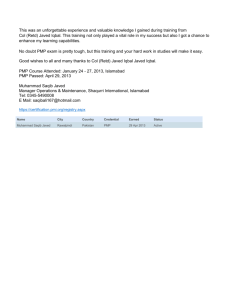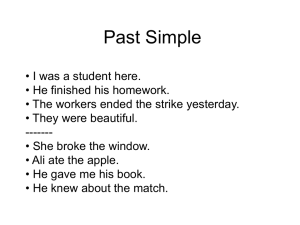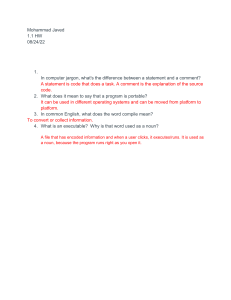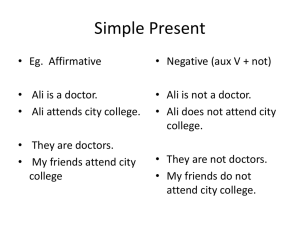Image Enhancement in Spatial Domain - Digital Image Processing
advertisement
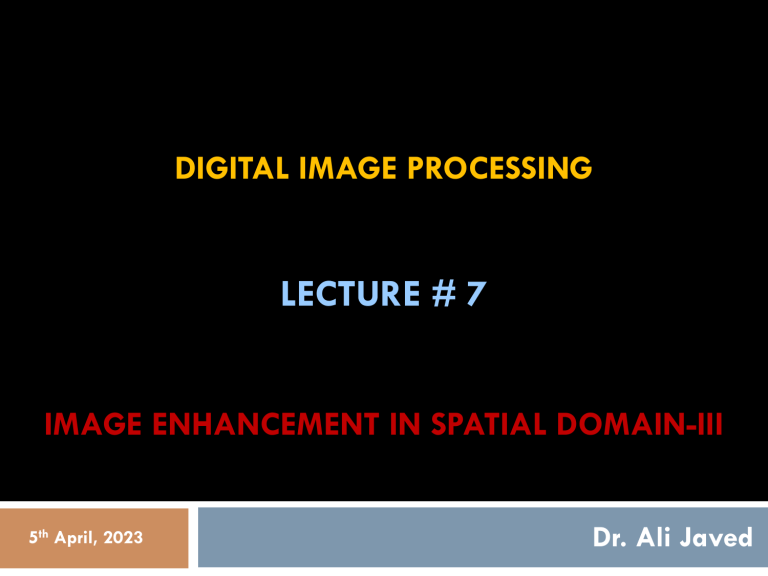
DIGITAL IMAGE PROCESSING LECTURE # 7 IMAGE ENHANCEMENT IN SPATIAL DOMAIN-III 5th April, 2023 Dr. Ali Javed Contact Information 2 q Course Instructor: Dr. Ali Javed Associate Professor Department of Software Engineering U.E.T Taxila ü Email: ali.javed@uettaxila.edu.pk Website: http://fms.uettaxila.edu.pk/Profile/ali.javed ü Research Lab: http://msplab.uettaxila.edu.pk ü Contact No: +92-51-9047747 Office hours: ü ü n Monday, 9:00 - 11:00, Office # 7 S.E.D q Lab Instructor: Engr. Nazia q Course TA: Ms. Qurat-ul-Ain Dr. Ali Javed 3 Topics to Cover § Sharpening Spatial Filtering § Edge Detection § Derivatives q 1st Order Derivative q 2nd Order Derivative § Laplacian Operator § Unsharp Masking § High Boost Filtering § Gradient Operators q Sobel Operator q Prewitt Operator Dr. Ali Javed q Robert Cross Operator Spatial Filtering for Sharpening 4 Background: To highlight fine detail in an image or to enhance blurred detail Applications: Medical imaging, industrial inspection etc. Foundation (Blurring vs Sharpening): § § Dr. Ali Javed Blurring/smoothing is performed by spatial averaging (equivalent to integration) Sharpening is performed by noting only the gray level changes in the image that is the differentiation Edge Detection 5 What is an Edge? Edge is a change but every change is not an edge Edge is a noticeable or abrupt change E.g 5 7 2 is not a noticeable change in the range of (0 to 255) We have to define a threshold if the change is more than a specified threshold then we will define it as an edge point. Here gradual change exists you cannot pinpoint where the edge exists so the change must be abrupt 50 55 60 65 70 For each pixel we have to look in horizontal, vertical and diagonal direction dx/ds -> for horizontal direction dy/ds -> for vertical direction dd/ds -> for diagonal direction Dr. Ali Javed 50 15 35 40 20 30 225 195 230 Edge Detection 6 Dr. Ali Javed Real Edges Noisy and Discrete! We want an Edge Operator that produces: ¤ Edge Magnitude ¤ Edge Orientation ¤ High Detection Rate and Good Localization Edge Types 8 q q Step edge: the image intensity abruptly changes from one value on one side of the discontinuity to a different value on the opposite side. Ramp edge: a step edge where the intensity change is not instantaneous but occur over a finite distance. Dr. Ali Javed Edge Types 9 q q Ridge edge: the image intensity abruptly changes value but then returns to the starting value within some short distance (i.e., usually generated by lines). Roof edge: a ridge edge where the intensity change is not instantaneous but occur over a finite distance. Dr. Ali Javed Spatial Filtering for Sharpening 10 Operation of Image Differentiation q Enhance edges and discontinuities (magnitude of output gray level > T) q De-emphasize areas with slowly varying gray-level values (output gray level: 0) Mathematical Basis of Filtering for Image Sharpening q First-order derivatives [Gradient] q Second-order derivatives Dr. Ali Javed Derivatives 11 First Order Derivative q A basic definition of the first-order derivative of a one-dimensional function f(x) is the difference ¶f = f ( x + 1) - f ( x) ¶x Second Order Derivative q Similarly, we define the second-order derivative of a one-dimensional function f(x) is the difference ¶ f = f ( x + 1) + f ( x - 1) - 2 f ( x) 2 ¶x 2 Dr. Ali Javed st 1 12 Dr. Ali Javed & nd 2 Order Derivatives st 1 & nd 2 Order Derivatives 13 First Order Derivative q Must be zero in area of constant gray levels q Non zero along the ramps q Non zero at the start of the gray level step or ramp Second Order Derivative q Zero in flat areas q Zero along the ramps of constant slope q Non zero at the start and end of the gray level step or ramp Dr. Ali Javed Example for Discrete Derivatives 14 Dr. Ali Javed Example for Discrete Derivatives 15 Dr. Ali Javed Steps to Apply Edge Detector Kernel 16 Dr. Ali Javed 1st Derivative Filtering- The Gradient 17 q q 1st derivative filters is Gradient which represents change For a function f(x,y) the gradient of f at coordinates (x,y) is given as the column vector: é ¶f ù éGx ù ê ¶x ú Ñf = ê ú = ê ¶f ú G ë yû ê ú êë ¶y úû Dr. Ali Javed 1st Derivative Filtering- The Gradient 18 q The magnitude of this vector is given by: Ñf = mag (Ñf ) [ = G +G 2 x 2 y ] 1 2 éæ ¶f ö 2 æ ¶f ö = êç ÷ + çç ÷÷ êëè ¶x ø è ¶y ø q The direction of this vector is given by: Dr. Ali Javed 2 ù ú úû 1 2 1st Derivative Filtering- The Gradient 19 q Now we want to define digital approximations and their Filter Masks q For simplicity we use a 3x3 region q For example, z5 denotes f(x,y), z1 denotes f(x-1,y-1) q A simple approximation for First Derivative is Dr. Ali Javed z1 z2 z3 z4 z5 z6 z7 z8 z9 1st Derivative Filtering- The Gradient 20 q Two other definitions proposed by Roberts use cross- difference q If we use Dr. Ali Javed Roberts Cross-Gradient Operators z1 z2 z3 z4 z5 z6 z7 z8 z9 A Simple Edge Detector- The Gradient 21 Dr. Ali Javed A Simple Edge Detector- The Gradient 22 Dr. Ali Javed Gradient Operators 23 q q Normally the smallest mask used is of size 3 x 3 Based on the concept of approximating spatial masks have been proposed Dr. Ali Javed the gradient several Gradient Operators 24 Dr. Ali Javed Gradient Operators 25 Dr. Ali Javed Gradient Operators 26 Dr. Ali Javed Sharpening Mask Coefficients 27 q Why the summation of coefficients in all masks of derivate operators equals to zero? Dr. Ali Javed Laplacian Mask: 2nd Order Derivative 28 Dr. Ali Javed Laplacian Mask: 2nd Order Derivative 29 Dr. Ali Javed Laplacian for Image Enhancement 30 q Image background is removed by Laplacian filtering. q Background can be recovered simply by adding original image to Laplacian output Dr. Ali Javed Laplacian for Image Enhancement 31 Dr. Ali Javed Image Sharpening Based on Un-sharp Masking 32 Un-sharp masking q Subtracting an unsharp (smoothed) version of an image from the original image is process that has been used since the 1930s by the printing and publishing industry to sharpen images. This process, called unsharp masking, consists of the following steps: 1. Blur the original image. 2. Subtract the blurred image from the original (the resulting difference is called the mask.) 3. Add the mask to the original. Dr. Ali Javed High Boost Filtering 33 q A slight further generalization of un-sharp masking is called High Boost filtering q A high boost filtered image, fhb, is defined at any point (x, y) as Principal application: q High Boost filtering is used when input image is darker than desired q High-boost filter makes the image lighter and more natural Dr. Ali Javed High Boost Filtering 34 Dr. Ali Javed High Boost Filtering Masks 35 Dr. Ali Javed High Boost Filtering Masks 36 Original Image Dr. Ali Javed High Boost Filtering Masks 37 Mask 1,A =1 Mask 2,A =1 Mask 1,A =1.5 Mask 1,A =2 Mask 2, A =1.5 Mask 2, A = 2 References 38 1. Dr. Ali Javed DIP by Gonzalez For any query Feel Free to ask 39 Dr. Ali Javed
